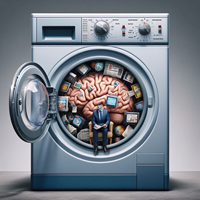By Ron Raskin

Brainwashing Machine – As a Contemporary Matrix.
Take a moment to ponder a simple question: why did people in Nazi Germany support the Nazi regime? Why were communists so fervently motivated to fight for revolution? Why does the population of Gaza support Hamas, while the population of Israel supports war against Hamas? And why do students at Colombian universities participate in anti-Israel demonstrations? In essence, what drives individuals to support particular ideas?
Is it because all Germans were inherently evil? Are all Palestinians, Israelis, or American students inherently malicious? In the realm of logic, assumptions are foundational, and it’s imperative to make them explicit. My fundamental assumption is this: the majority of people are inherently good and genuinely believe that what they perceive as right is indeed right, while what they perceive as wrong is indeed wrong.
Yet, how can we reconcile this with historical instances where entire nations seemingly “lost their minds” and embraced abhorrent ideologies like Nazism? The common answer is “propaganda.” But what exactly is propaganda, and perhaps more crucially, how can we be certain that our own beliefs and convictions aren’t merely products of propaganda? How do we ensure that we’re on the “right” side of history?
The Mechanics of a Brainwashing Machine.
In this discourse, we’ll delve into the mechanics of propaganda and explore methods to discern whether we’re ensnared in a mental construct akin to the “matrix.” But before we proceed, let’s briefly consider how our brains operate: we receive signals from the world—whether visual, auditory, or textual—and our minds construct our perception of reality based on these signals. Altering these signals effectively alters our reality. This fundamental principle lies at the heart of any brainwashing machine.
How can we harness this for the construction of a brainwashing apparatus? Propaganda, at its core, comprises three key elements: deception, selective facts, and the emotional manipulation of those facts. Deception may hold less sway in the Western sphere, given the ubiquity of information and the potential legal repercussions. However, consider the power of selective facts. Imagine I relayed a simple fact: an elderly man was killed. What emotions surface? Now, add a layer: the woman who killed him was defending herself from assault. Suddenly, the narrative shifts. The fundamental truth remains unchanged—the man is dead—but the additional details influence our understanding and emotions. This demonstrates how even minor omissions can warp perception. No outright lies necessary; merely a strategic omission of facts.
And then there’s sentiment. If I describe someone as hyperactive, it doesn’t reflect well on them, does it? But if I say they are very energetic, it sounds different, right? Although the meaning is essentially the same, it’s just our opinion that shapes the perception of the fact. That’s all!
But is this all it takes to construct an effective brainwashing mechanism? Almost, but not quite. Consider the impact of foundational beliefs. For instance, if someone does not adhere to religious doctrine, the statement “scientists claim dinosaurs roamed the Earth 65 million years ago” may seem straightforward. However, for those with strong religious convictions, does this pose a quandary and contradict their teachings? Not necessarily. One might reconcile this by positing that the world, as we know it, was formed a mere few thousand years ago, with the appearance of age crafted by a divine hand.
If we alter our fundamental assumptions or axioms on a given topic, we can arrive at vastly different logical interpretations of the same set of facts. While logic is indispensable, it’s essential to exercise caution, as it can sometimes deceive us. Regarding propaganda, when individuals hold different axioms, it becomes effortless to peddle divergent realities. Even when presented with opposing facts, individuals entrenched in their own set of axioms remain steadfast in their views.
How do you form these axioms? Through feelings! While you can present various facts to someone, changing feelings that are deeply ingrained from childhood is nearly impossible. Transforming people’s perspectives takes a long time, much like spending 40 years in the desert. An interesting observation: if two groups of people have different feelings about something, it suggests there can be two valid but opposing worldviews. Alternatively, you could say there are two “bad” sides, which is essentially the same idea viewed with a different sentiment.
How then, do we discern if we’re ensnared in this mental web? Ask yourself the following questions:
- Do I understand why others think the way they do? If we assume that most people are inherently good, then why do they believe in things we consider “bad”? If you can’t answer this, it’s a concerning sign. It doesn’t necessarily mean you are on the “bad” side—most American and Soviet citizens during WWII couldn’t understand where Nazi ideas originated, yet they were on the right side of history. However, it does suggest that you might have been brainwashed and are susceptible to manipulation.
- If you do understand how others think, then ask yourself: do you grasp their basic assumptions, their axioms? If you can, then there is a good chance your perception of the world is accurate and well-informed. Congratulations!
Be careful and let the wisdom be with you!

